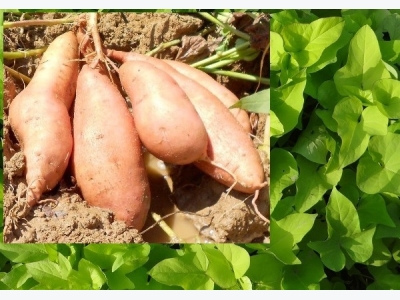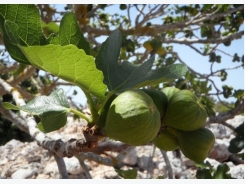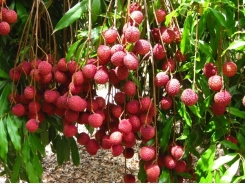Sweet Potato Cultivation Guide

Introduction to Sweet Potato Cultivation:- The sweet potato is an important crop and basically grown for its starchy tuberous roots in tropical and sun-tropical regions. The Sweet Potato crop is an herbaceous perennial vine which bears alternate heart shaped leaves and medium sized sympetalous flowers. The edible root is long and tapered with a colour range from yellow, brown, red, purple and beige. When it comes to sweetness, pale yellow or white flesh (skinned) are less sweet when compared to pink, red or orange flesh. Sweet potatoes are locally known by other names; for example In India it is called as ‘Sakharkanda’, “yam” and kumara. The young leaves of potato plants and shoots are sometimes consumed as greens. Sweet potato is often called a “yam” in some parts of world. However, one should realise that the sweet potato is botanically very distinct from a genuine yam. Sweet potato is known for their high calorie content. This root is eaten after baking, grilling, and boiling. Apart from culinary purposes, it has very good industrial uses as well. The sweet potato is a good source of starch, glucose, sugar syrup and industrial alcohol. The sweet potato produces highest food calories when compared to other tuber and root crops horticulture sector. The sweet potato crop also grown for livestock feed. The following write-up details about “how to grow sweet potatoes”. Commercial sweet potato cultivation can be done even in controlled environments such as greenhouse and polyhouse.
Scientific Name or Botanical Name of Sweet Potato:- Ipomoea batatas (L.) Lam.
Genus of Sweet Potato:- “Ipomoea”.
Family Name of Sweet Potato:- “Convolvulaceae”.
Top 10 Countries of Sweet Potato Production:- The following are top 10 production countries of sweet potato
- China
- Nigeria
- Uganda
- Indonesia
- Tanzania
- Viet Nam
- Ethiopia
- USA
- India
- Rwanda.
Sweet Potato Other Names:- Zoete aardappel (Dutch), Süßkartoffel (German), амтлаг төмс (Mongolian), batat (Polish), Batati macaan (Somali), patate e ëmbël (Albanian), bataat (Estonian), γλυκοπατάτα (Greek), prátaí milse (Irish), 고구마 (Korean), Patata Helwa ( Maltese), Sakar khand (Nepali), batata doce (Portuguese), slatki krompir (Serbian), batata (Spanish), الحلوة البطاطا) Arabic), батат (Bulgarian), hóng shǔ (Chinese), kamote (Filipino), patata dolce (Italian), søtpotet (Norwegian), มนั เทศ (Thai), cây khoai lang (Vietnamese), Քաղցրահամ կարտոֆիլ(Armenian), Ka Zoon Au (Burmese), satsuma-imo (Japanese), Saldie kartupeļi (Latvian), cartofi dulci ( Romanian), බතල (Sinhalese), Domlong Chhvea (Cambodian), batata (Czech), Patate douce (French), Shakkar Kandi (Hindi, India), Батат (Russian), sötpotatis (Swedish), tatlı patates (Turkish), ბატატი (Georgian), batat (Danish), Édesburgonya (Hungarian), ubi keledek (malay), hanzuu (Taiwanese). Indian Names of Sweet Potato: Hindi (Shakar Kand / Ratalu), Tamil (Sarkaraivalli Kizhangu), Malayalam (Madhura Kizhangue), Marathi ( Ratala), Telugu (Genusu/Denusu/Moram gadda), Kannada (Genasu), Bengali ( Mithia-Aloo / Mishti Alu), Gujarati(Shakkaria), Konkani (Kanngi), Oriya(Chini-Aloo / Kandamoola), Punjabi(Shakar Kand / Ratalu) and Tulu(Kereng).
Health Benefits of Sweet Potato:- The below mentioned are some of the health benefits of sweet potatoes.

Sweet Potato Health Benefits.
- Sweet potatoes are good source of calories (energy).
- They are high in vitamin B6 and good source of Vitamin ‘C’ and ‘D’.
- Sweet potatoes contain iron and support a healthy immune system.
- Sweet potatoes are a good source of magnesium, which helps in reducing stress levels.
- Sweet potatoes are a source of potassium.
- Sweet potatoes help to prevent constipation and promote regularity for a healthy digestive tract.
- Sweet potatoes are considered low on the glycemic index scale and they will not cause blood sugar spikes.
- Sweet potatoes are good for anti-aging.
- Sweet Potatoes may boost immune power.
Sweet potatoes help in reducing “Inflammation”.
Sweet Potatoes are good for eye health.
Cultivars (Varieties) of Sweet Potato:- There are many cultivars of sweet potatoes being grown throughout the world. Here are some of the popular cultivars; Allgold, Apache, Beauregard, Brinkley White, Bunch Porto Rico, Carolina Ruby, Centennial, Cherokee, Continental Red, Cordner, Cordner’s Red, Dianne,Garnet, Georgia Jet, Hannah, Hayman, Hernandez, Jewell , Porto Rico, White Delight, and White Hamon Sweet Potatoes. Indian Varieties: Varsha, Konkan Ashwini, Co 3,H-41, H-42, Co CIP 1, Sree Nandini, Sree Vardhini, Kiran, Sree Bhadra, Sree Rethna, Gouri and Sankar,Kanjanghad, Sree Arun and Sree Kanaka.

Pink Sweet Potato.
Climate Requirement for Sweet Potato Cultivation:- Well, sweet potatoes require warm and humid climatic conditions at least for 4 to 5 months in the year. The ideal temperature range required for sweet potato production is 22°C to 28°C. Sweet potato can be grown both as tropical and subtropical crop. However, for good yield and healthy produce, this crop requires well-distributed annual rain fall of 75 – 150 cm. Cool nights and sunny days are best for better tuber development. It can be grown in the hills up to an altitude of 1500 – 1700 meters as a summer crop.
Soil Requirement for Sweet Potato Cultivation:- Any successful farming mainly depends on the type of soil. This crop requires loose friable soil as tuber growth takes place inside the ground/soil. Even though it can be grown on wide range of soils, the best suitable soils are sandy loam soils rich in organic matter. This crop also requires well-drained soils as it does not tolerate water logging in the field. Commercial growers are recommended to go for soil test for finding the soil fertility. Heavy clay soils, compact soils (which have poor aeration) and highly sandy soils should be avoided. The ideal soil pH for sweet potato cultivation is 5.8 to 6.6
Land Preparation in Sweet Potato Cultivation:- Land should be ploughed thoroughly and bring to fine tilth stage. The soil depth should be at least 30 cm for better tuber and root development. Ridges and furrows should be formed at 60 cm distance. However, Sweet potatoes can also be grown in beds.
Propagation in Sweet Potato Cultivation:- Sweet potato can be propagated by tubers clips or vine cuttings. However, vine cutting is a very common propagative method and widely practiced. Vine cuttings of sweet potato can be procured from any certified nurseries. Nursery raised vine cuttings of 20 to 25 cm length (with 2 – 3 nodes) should be transplanted in the main field. Vine cuttings should be dipped in a solution by mixing 400 grams of Azospyrillum in sufficient water.
Seed Rate, Planting/Sowing and Spacing in Sweet Potato Cultivation:- Seed rate/Plant rate depends on soil type, cultivar and method of planting. Generally, this crop requires about 45 to 50 thousand cuttings/ha. Once Vines are grown on nursery beds for required length and nodes, they should be planted on ridges 60 cm apart and at a distance of 20 cm between the vines. The cuttings can also be planted on mounds at 70 x 70 cm spacing. On the top of each mound 4 to 6 cuttings should be planted. Middle portion of vine cutting should be planted deep in the soil and two cut ends should be exposed to the surface. Irrigate the field after planting as it requires for good root establishment.
Irrigation in Sweet Potato Cultivation:- In any crop, frequency of irrigation depends on many factors such as soil type (moisture holding capacity), planting method, and climatic conditions. Make sure to irrigate the field just before planting of tubers or vines. After this, carry out irrigation on third day of planting. Subsequent irrigations should be provided once in a week. Irrigation should be halted (stopped) 1 week before of harvesting the crop. Make sure towell-drain the plant base as excessive moisture supply deteriorates the quality of sweet potato tubers.
Manures and Fertilizers in Sweet Potato Cultivation:- Proper and timely manures and fertilizers ensure healthy produce and higher yields of the crop. Well-decomposed farm yard manure(like cattle manure) or compost @ 20-25 tonnes/ha should be applied during land preparation (ridge formation).The required N:P2O5:K2O is 75:50:75 kg/ha. Nitrogen (‘N’) should be applied in 2 equal split doses The first dose of ‘N’ should be applied at the time planting and second dose should be applied 5 weeks after planting. K2O and P2O5 should be applied in full doses at the time of planting.
Intercultural Operations in Sweet Potato Cultivation:- Weed free field is essential for any crop. To suppress the weeds carry out 2 weeding and earthing up tasks about 2 weeks and 5 weeks after planting in the field. The top dressing of fertilizers should be done along with the second inter-cultivation. By turning the vines occasionally (During growth phase) would prevent the small slender tubers at the nodes.
Pests and Diseases in Sweet Potato Cultivation:- Controlling pests and diseases is one of primary indicator of successful farming.
- Pests: Sweet potato weevil is the common pest found in sweet potato cultivation. To prevent this, use pest free planting material and if any previous sweet potato crop residues should be removed. Proper earthing and vine treatment should be done.
- Diseases: Soft rot is the common disease found in sweet potato cultivation. This disease can be controlled by spot drenching with Carbendazim 1 gram/liter of water.
Note: Your local Horticulture is a good source for finding suitable solutions for controlling pests and diseases in Sweet Potato Cultivation.
Harvesting in Sweet Potato Cultivation:- The matured crop will be ready after 4 (120 days) months of planting. However, this time frame may vary from variety to variety. The easy way of identifying the mature crop is when the leaves turn into yellow colour and matured tuber. The crop can be harvested by digging out the tubers

Raw Sweet Potato.
Yield in Sweet Potato Cultivation:- Yield of crop depends on cultivar (variety), soil type, climatic condition and irrigation facilities and other horticulture management practices. In case of sweet potato production, one can obtain 25 tonnes/ha yield under ideal conditions. Usually an irrigated crop yields more when compared to rain-fed crop.
Marketing of Sweet Potato:- Freshly harvested sweet potatoes can be transported to local markets or starch related industry.
Bottom Line of Sweet Potato Cultivation:- One can easily obtain good profits by going for sweet potato production.
Có thể bạn quan tâm
Phần mềm

Phối trộn thức ăn chăn nuôi

Pha dung dịch thủy canh

Định mức cho tôm ăn

Phối trộn phân bón NPK

Xác định tỷ lệ tôm sống

Chuyển đổi đơn vị phân bón

Xác định công suất sục khí

Chuyển đổi đơn vị tôm

Tính diện tích nhà kính

Tính thể tích ao hồ




 Dragon Fruit Farming Information Guide
Dragon Fruit Farming Information Guide  Lychee Fruit Cultivation Information Guide
Lychee Fruit Cultivation Information Guide